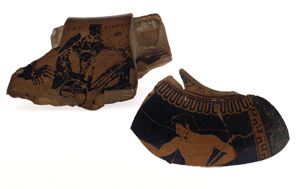|
||
      |
Original Source
Graphic arts
 As
soon as words came uncoupled from hieroglyphs and the written alphabet shook
off the language of pictures, “people started wanting to bring them
back together,” says classics scholar Glenn Most, who with art historian
Richard Neer has curated a Smart Museum exhibit on language in ancient art.
Using artifacts from the museum’s permanent collection, the exhibit,
Graphiké (which can mean both writing and drawing), explores
interactions between text and pictures in quotidian Greco-Roman life. Those
interactions, they say, were indirect, tenuous, and complicated. For example,
dating from 550–530 BC, a rim fragment of a wine decanter called a
dinos (left) portrays a chariot warrior hurtling into battle beneath
an inscription that conjures epic literature, identifying him as Diomedes,
a hero from Homer’s Iliad. Behind his head, the word kalos
proclaims him “beautiful” or “noble.” Intact, the
dinos’s entire rim would have been ringed with other chariots
and a fleet of sailing ships, evoking (when the bowl was full) Homer’s
“wine-dark sea.”
As
soon as words came uncoupled from hieroglyphs and the written alphabet shook
off the language of pictures, “people started wanting to bring them
back together,” says classics scholar Glenn Most, who with art historian
Richard Neer has curated a Smart Museum exhibit on language in ancient art.
Using artifacts from the museum’s permanent collection, the exhibit,
Graphiké (which can mean both writing and drawing), explores
interactions between text and pictures in quotidian Greco-Roman life. Those
interactions, they say, were indirect, tenuous, and complicated. For example,
dating from 550–530 BC, a rim fragment of a wine decanter called a
dinos (left) portrays a chariot warrior hurtling into battle beneath
an inscription that conjures epic literature, identifying him as Diomedes,
a hero from Homer’s Iliad. Behind his head, the word kalos
proclaims him “beautiful” or “noble.” Intact, the
dinos’s entire rim would have been ringed with other chariots
and a fleet of sailing ships, evoking (when the bowl was full) Homer’s
“wine-dark sea.”
Depicting a shirtless Leagros, a handsome young Athenian aristocrat and military general who made appearances on many pots, a pelike—an oil or wine jar—fragment (right) also bears the word kalos. Dating from 510 BC and found in Italy, the fragment shows Leagros with a marten, a typical affectionate gift from an older man.
Elsewhere in the exhibit, a piece of painted pottery dedicated to Athena reaches for prestige with a typeface connoting a more expensive stone offering. Early Christian oil lamps are inscribed with nonsense letters that conveyed the aura of literacy, “which,” Most says, “connects to the idea of light, illumination, salvation—it’s very resonant.”
Words, Neer adds, are not merely the sum of their meaning. “Today we’re trained to think about words only in terms of their semantic significance,” he says. “But words convey all kinds of things,” socially, rhetorically, aesthetically, and culturally.